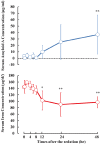Serum iron concentration as a marker of inflammation in young cows that underwent dehorning operation
- PMID: 30828032
- PMCID: PMC6483902
- DOI: 10.1292/jvms.19-0002
Serum iron concentration as a marker of inflammation in young cows that underwent dehorning operation
Abstract
This study aimed to assess the usefulness of serum iron (Fe) concentration as a marker of inflammation caused by the dehorning operation. Five young Holstein cows aged 205.0 ± 10.7 days and weighing 207.2 ± 24.1 kg underwent the dehorning operation. Blood samples were withdrawn before dehorning (pre) and at time periods of t=0.5, 2, 4, 6, 8, 12, 24, and 48 hr. The serum amyloid A (SAA) concentration was significantly high at t=48 hr (P<0.01). The serum Fe concentration significantly decreased, reaching 90.0 ± 36.4 µg/dl at t=24 hr (P<0.001). Therefore, serum Fe concentration showed significant and negative correlation with SAA concentration (r2=0.500, P<0.01). In conclusion, serum Fe concentration is a useful marker of inflammation in young cows that have undergone the dehorning operation.
Keywords: Inflammation; calf; dehorning; iron; serum amyloid A.
Conflict of interest statement
The authors have no conflict of interests directly relevant to the content of this article.
Figures


Similar articles
-
Serum amyloid A concentrations in cows given endotoxin as an acute-phase stimulant.Am J Vet Res. 1989 Oct;50(10):1690-4. Am J Vet Res. 1989. PMID: 2508514
-
[Tetanus in cattle caused by dehorning with rubber bands].Dtsch Tierarztl Wochenschr. 1981 Sep 5;88(9):382-3. Dtsch Tierarztl Wochenschr. 1981. PMID: 7030699 German. No abstract available.
-
Effect of castration and dehorning singularly or combined on the behavior and physiology of Holstein calves.J Anim Sci. 2013 Feb;91(2):935-42. doi: 10.2527/jas.2012-5190. Epub 2013 Jan 3. J Anim Sci. 2013. PMID: 23287529 Clinical Trial.
-
Routine surgical procedures in dairy cattle under field conditions: abomasal surgery, dehorning, and tail docking.Vet Clin North Am Food Anim Pract. 2005 Mar;21(1):55-72. doi: 10.1016/j.cvfa.2004.11.002. Vet Clin North Am Food Anim Pract. 2005. PMID: 15718087 Review.
-
Equine Inflammatory Markers in the Twenty-First Century: A Focus on Serum Amyloid A.Vet Clin North Am Equine Pract. 2020 Apr;36(1):147-160. doi: 10.1016/j.cveq.2019.12.005. Epub 2020 Jan 30. Vet Clin North Am Equine Pract. 2020. PMID: 32007299 Free PMC article. Review.
Cited by
-
Evaluation of blood serum iron concentration as an alternative biomarker for inflammation in dairy cows.Biol Trace Elem Res. 2023 Oct;201(10):4710-4717. doi: 10.1007/s12011-022-03544-5. Epub 2023 Jan 9. Biol Trace Elem Res. 2023. PMID: 36622523
-
Association of Stress and Inflammatory Diseases with Serum Ferritin and Iron Concentrations in Neonatal Calves.Animals (Basel). 2025 Apr 2;15(7):1021. doi: 10.3390/ani15071021. Animals (Basel). 2025. PMID: 40218414 Free PMC article.
-
Serum iron concentration is a useful biomarker for assessing the level of inflammation that causes systemic symptoms in bovine acute mastitis similar to plasma haptoglobin.J Vet Med Sci. 2020 Oct 20;82(10):1440-1444. doi: 10.1292/jvms.20-0388. Epub 2020 Jul 29. J Vet Med Sci. 2020. PMID: 32727966 Free PMC article.
-
The platelet and plasma proteome and targeted lipidome in postpartum dairy cows with elevated systemic inflammation.Sci Rep. 2024 Dec 28;14(1):31240. doi: 10.1038/s41598-024-82553-x. Sci Rep. 2024. PMID: 39732778 Free PMC article.
-
Effect of high-concentrate corn grain diet-induced elevated ruminal lipopolysaccharide levels on dairy cow liver function.J Vet Med Sci. 2020 Jul 31;82(7):971-977. doi: 10.1292/jvms.20-0117. Epub 2020 May 27. J Vet Med Sci. 2020. PMID: 32461536 Free PMC article.

